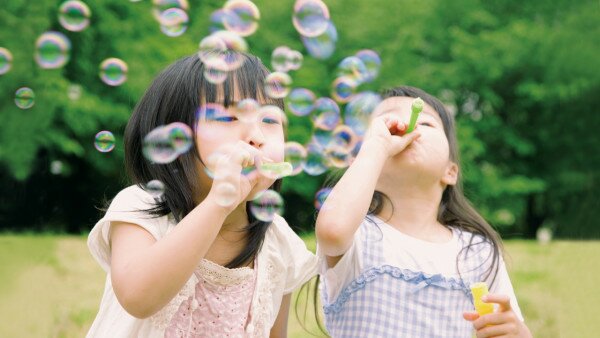Bubbles shimmering with the colours of the rainbow in the sunlight are well-liked by both adults and children. But these soap bubble toys may contain microorganisms or pathogens that parents should not overlook their risks. The Consumer Council carried out tests on 12 randomly selected models of common soap bubble toys and found that the total microbial count was relatively higher in 2 models and in one of those a pathogen was detected. The test results were passed to the Customs and Excise Department for follow-ups. The Council reminds parents to read information on product label such as manufacturing date, expiry date and period of use carefully. The product should be used up as quickly as possible after it is opened and wash the skin and clothes at once after playing with soap bubbles to reduce the chance of bacterial infection.
The 12 models were purchased from department stores, supermarkets, toy stores and stationary shops. The models included traditional types (4), refills (2), electric or manual soap bubble guns (4) and bubble-blowing swords or pencils (2).
The test referred to the Recommendations and Protocols issued by notified bodies NB-Toys under the EU Toy Safety Directive and European Pharmacopoeia to examine the hygienic condition of all models. Test results revealed that 2 models contained an amount of total aerobic microbial count of 4,600 CFU/g and 5,200 CFU/g, exceeding the limit set under the Recommendations (1,000CFU/g or CFU/ml).
A study report issued by the Bureau of Standards, Metrology & Inspection of Taiwan indicated that if children get in contact with soap bubble toys containing excessive amount of microorganisms, such as touching the eyes afterwards, or have meal without first washing their hands might have bacterial infection with symptoms like red eyes, conjunctivitis, swollen throat, skin irritation, gastroenteritis and fever.
Apart from containing total microbial count above the limit, 1 of the tested models was also found to contain a pathogen – Pseudomonas aeruginosa. A study from Italy revealed that there were young children who developed symptoms like lower limb pain, sore throat and fever after playing with a bottle of soap bubbles detected with Pseudomonas aeruginosa. They were later diagnosed with bacterial sepsis from blood tests.
The Council reminds parents that soap bubble toys with Pseudomonas aeruginosa they might cause serious infection in children who are feeling unwell, having a weakened immune system or suffering from severe illnesses such as primary immunodeficiency disorder or leukemia, or having recently gone through chemotherapy, or open wounds.
Bacterial contamination of soap bubble toys could arise from packaging material with poor sealing used by manufacturers, improper storage condition or failure of preservatives in soap bubble solutions. At present, Hong Kong neither has legislation nor toy safety standards requiring that toys and children products be labelled with information such as manufacturing date, expiry date or period of use. The Council recommends manufacturers label the said details clearly to facilitate parents to choose more recently made products.
Moreover, some soap bubble solutions with glycerin or syrup may be a good medium for the growth of microorganisms, or may have added preservatives that could easily cause allergic reactions (such as Methylisothiazolinone or MIT). Parents should not take it lightly and should check whether children feel unwell or have symptoms like allergic reactions after playing.
When children play with soap bubble toys, the Council has the following advice:
- Purchase the product with a relatively recent manufacturing date, check whether the packaging is intact and finish it as soon as it is opened;
- Parents should accompany their young children when playing with soap bubble toys to safeguard their children against accidental ingestion of the solution;
- Parents should teach their kids how to play safely with soap bubble toys, especially with soap bubble guns. Children should be caution against pointing the guns at others faces to avoid hurting the eyes or allowing the solution to come into contact with skin and eyes;
- After playing with soap bubble toys, wash the hands and clothes that have been in contact with the solutions as soon as possible.
The Consumer Council reserves all its right (including copyright) in respect of CHOICE magazine and Online CHOICE.




